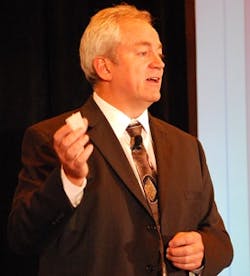Emerson Charms User Group with Introduction of DeltaV S-Series
This is a tale in three parts. The first is about the demographics of automation and the process industries; the second is about human-centered design; and the third part is about technology. Steve Sonnenberg, president of Emerson Process Management, introduced the new version of DeltaV by calling it "the product of a new type of product development: human-centered design."
Sonnenberg, and after him, Peter Zornio, Emerson's Chief Strategic Officer, explained the research that went into the design factors that in turn led to the new incarnation of DeltaV. Sonnenberg noted the "perfect storm" of more technology, a retiring workforce, inexperienced workers, larger and more complex processes, fewer specialists and even fewer incoming workers. He said that Emerson started investing five years ago to address these issues, because, one of his customers told him, "We just want to drive the car. We don't need to know how to build the car."
Sonnenberg announced the first two products based on human-centered design (HCD), the DeltaV S-series with "I/O on Demand," and the latest release of AMS Device Manager with Device Dashboards for more than 50 devices.
Peter Zornio said that HCD is different because it is "looking at the complete work process design for how people need to do their job." He said that applying HCD principles delivers a dramatically enhanced user experience where traditional product development methodology delivers a continued refinement of the same approach—with little incremental value.
What we've done with the DeltaV S-series is to streamline the project engineering process, Zornio continued. "The S-series has redesigned the control and I/O subsystem, and it delivers a step change in project efficiencies, while the new ‘I/O on Demand' feature gives users ‘what you want, when you want it, where you want it.' This is an automation breakthrough that eliminates the intensive pre-engineered work associated with I/O."
Zornio showed I/O on Demand in three regions: wireless, bussed and wired marshalling. He noted that fully redundant wireless has proven robust enough to handle nearly all control requirements. Duncan Schleiss, vice president of platform strategy, interjected that he believed "Forty-four percent of process control inputs can be wireless with no difficulty." Zornio said that translates into a reduction in cost of approximately 20% in a wireless design, using S-series I/O on Demand. "Wireless eliminates work," he said. "Getting rid of wires eliminates most activities associated with wiring design and installation. Cabinets, wire, terminations, cable tray design, fusing, installation drawings and a host of other activities are gone."
Even fieldbus can be made more productive and inexpensive with the new S-series platform. "Emerson integrates fieldbus power conditioners onto H1 cards, eliminating third-party power conditioners, bulk power supplies for H1, and cabinets and engineering. S-series I/O on Demand lowers costs and engineering, while built-in diagnostics also lower cost, eliminate special tools and special training," Zornio said.
It is in wired marshalling, however, that the biggest achievement of the DeltaV S-series is found.
According to Zornio, the savings from using what Emerson is calling "electronic marshalling" in a project with 15,341 hardwired points works out to a 50% reduction in the number of controller cabinets, a 40% reduction in the cabinet footprint and a whopping 90% reduction in intra-cabinet wiring. "We can do this because we're completely eliminating the ‘spaghetti wiring' used to connect marshalling terminals to I/O terminals and then to controllers," he stated.
The heart of the matter is a hidden digital bus that provides electronic marshalling, with a new type of I/O card called a "Charm" or Characterization Module. The Charm is an A/D converter that takes the field I/O, digitizes it and puts it on the redundant Ethernet DeltaV bus so any I/O can be reported to any controller. In addition, Zornio says Emerson is prepared to produce standard rack-room marshalling cabinets pre-designed and pre-manufactured at Emerson. This effectively eliminates the conventional FAT.
"DeltaV S-series transforms the PlantWeb architecture," Zornio said. "Wireless should be part of any project. Integrated, redundant wireless allows the replacement of wired measurement and control points. A wireless infrastructure gives plants a flexibility to respond during the whole life cycle. Fieldbus becomes even more cost-effective. Integrated power management and built-in diagnostics lower cost, reduce engineering and eliminate special tools. And finally, Electronic Marshalling changes the game for wired points. Single-channel CHARMS and controller independence allow the first real updates to 35-year-old engineering practices."



